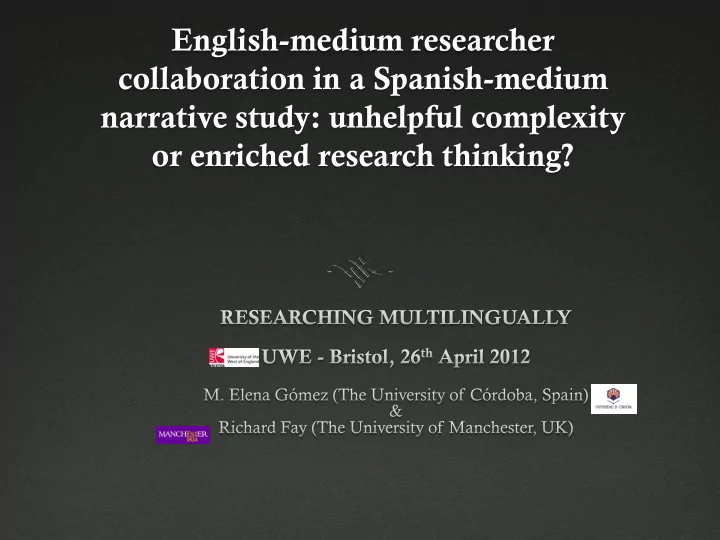

English-medium researcher collaboration in a Spanish-medium narrative study: unhelpful complexity or enriched research thinking?
1. Project – review & research The Educational Project [since 2007]: 15 TTs per year from Cordoba undertake a Practicum in Saharan refugee camps. Practicum Review [ongoing]: including insider and outsider perspectives. The Research Project [since 2010]: English-medium, collaboration in a narratively-framed intercultural study … to learn more about the value of the Saharan Practicum from the TTs’ perspective and to see if it provided them with IC learning opportunities.
1. Project – review & research
2. The Saharan context The Saharan project is set in a multilingual context: Saharan teachers and pupils speak Spanish & Hassaniyya - ةيناسح (a dialect of Arabic). Participating TTs & tutors: Spanish L1. TTs & tutors undertake (essentially in Spanish) the Practicum in a ML context.
2. The Saharan context
3. Choosing to research multilingually (1) Research project is multilingual (Spanish & English): Spanish-medium: data and initial analysis; English-medium: researcher collaboration, further data analysis & research reporting. As researchers, we chose to work in English because: English is our main/normal means of communication; English is our mutually-shared professional and academic/research language. Multilingual complexities (and riches) result, not from necessity, but from our choice.
3. Choosing to research multilingually (2) Leah Davcheva & Richard Fay – Ladino paper (Durham) Four RM spaces : Researched space (monolingual Practicum in the multilingual Saharan camp context). Research space (Spanish-medium texts, Spanish and English analysis). Researcher space (primarily English-medium). Presentation space (initially English-medium).
3. Choosing to research multilingually
4. Framing the research Our goal was to analyze students’ reports on their experience in the camps of Saharan refugees. BUT such reports were written in Spanish so, our first tasks were: To decide our goals; To find and construct a systematic and consistent tool for our analysis (cf. Bennett); To translate TTs’ reports into English (only the main ideas).
4. Framing the research
5. The research process (8 steps) Step 1 : identifying the Spanish- medium data (TTs’ reports). Step 2 : deciding to collaborate in English on such data (ML). Step 3 : specifying our research aim (IC-related). Step 4 : surfacing E’s project experience (reflexivity). Step 5 : discussing (in English) the methodology. Step 6 : discussing (in English) the IC conceptualisation. Step 7 : analysing (in Spanish plus English) the Spanish texts. Step 8 : disseminating the research (English-medium article).
5. The research process (8 steps)
6. Analysis complexities (1) Analysis based on categorising TTs’ statements vis -à-vis Bennett’s Ethnocentrism Ethnorelativity model. TTs’ texts are imprecise - when analysed from an L1 Spanish perspective, E. felt ambiguity and unease. Unease arose from contrasts between her reflexive interaction with what the TTs were saying and what they claimed. Ambiguity arose because of difficulty of translating key ideas into English for purposes of researcher discussions.
6. Analysis complexities (2) TTs experienced discipline in Saharan schools (e.g. Saharan teachers hit pupils’ hands with a ruler). TTs’ reactions recorded in Spanish, e.g. ‘ Temí que le hiciera daño al alumno ’. Difficult to translate into English: ‘ Fear/panic/dread ’ ?? So, English-medium researcher-discussion necessitated : Scrutiny of L1 Spanish analysis of Spanish-medium texts; Determination of exactly what the TTs might have meant (with implications for how the data are categorised re Bennett’s model)
6. Analysis complexities (3) E.g.: sense – experience (English) = experimentar (Spanish). The first set in English gives us the possibility to choose. So, when trainees use experimentar , we have two terms in English to specify if the feeling was either through the senses ( to sense ) or if it was an experience, a sensation ( to experience ). The lexical field of emotions is quite complex and the comparison of it in Spanish and English shows that English is richer than Spanish (especially in the negative axis).
6. Analysis complexities (4) Reflexive dimension. Textual dimension. Linguistic/Translation dimension. Overall, the process of researcher-discussion in English forced a spotlight on the otherwise unremarked upon, unmarked analytical operations in Spanish.
6. Analysis complexities
7. Conclusions (1) So: Unhelpful complexity or enriched research thinking ? Linguistic complexities of: The setting for the TTs’ Practicum, i.e. the multilingual Saharan camps (Spanish/Hassaniyya). The TT’s academically -focused texts about the Practicum experience (monolingual). The research process (including Spanish and English work on the Spanish-medium data). The researcher discussions (largely English-medium).
7. Conclusions (2) Enrichment : The research process : IC analysis – via ML process – is a kind of double- processing of the meaning of TTs’ insights. The project evaluation : these double-processed insights helpfully inform Practicum evaluation and finetuning. Researcher development : Methodological insights re researching multilingually. English-medium research concerns lead to greater awareness of the role of reflexivity and transparency in the research process. English-in-analysis encouraged scrutiny of unmarked L1 interpretations of likely participant meanings Spanish and English dissemination potentially
7. Conclusions
English-medium researcher collaboration in a Spanish-medium narrative study: unhelpful complexity or enriched research thinking?
Recommend
More recommend